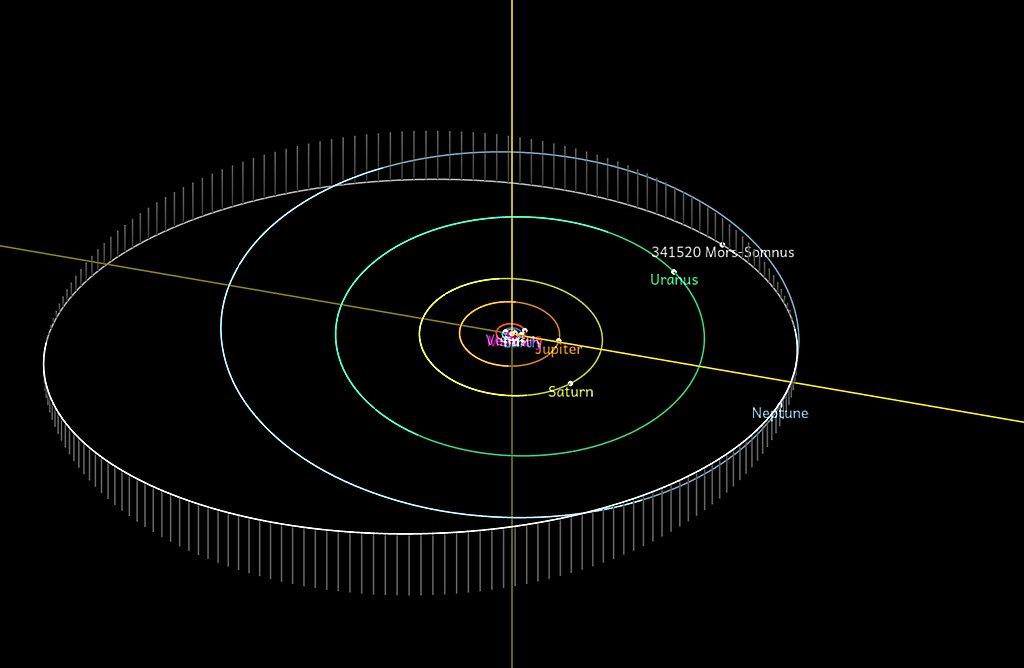James Webb Space Telescope data on distant worlds confirm some solar system formation hypotheses and confuse others.

Angela Ramirez (University of Central Florida)
The James Webb Space Telescope (JWST) was highly anticipated for the infrared vision that would allow it to peer deep into the past at extremely redshifted galaxies. But light from the same infrared wavelengths can be found much closer to home, radiated from the Sun and reflected from solar system worlds. For solid planetary surfaces, near-infrared reflections (with wavelengths from 700 to 5,100 nanometers) contain a wealth of information about what materials a world is made of.
JWST performed infrared spectroscopy on 59 distant bodies over the past two years, reading the compositions of these tiny, dim worlds for the first time. The program, called “Discovering the composition of the trans-Neptunian objects, icy embryos for planet formation” (DiSCo-TNOs), is led by Noemi Pinilla-Alonso (University of Central Florida)

Eurocommuter~commonswiki / CC BY-SA 2.5 Deed
One of DiSCo-TNOs’ targets, 341520 Mors–Somnus is a wide, equal-size binary: Mors and Somnus are both about 110 kilometers (68 miles) across and twirl around each other at a separation of about 21,000 kilometers.
Wide binaries are rare in most of the solar system because they are so fragile. Their large separation means it is very easy for some passing object to tug them apart. The only place they are common is in the core of theKuiper belt, between about 42 and 47 astronomical units (for context, that’s more than 10 a.u. beyond Neptune’s orbit at 30 a.u.). In this classical Kuiper belt, many small, dark, reddish worlds (or cold classicals for short) circle the Sun on low-inclination orbits.
The occurrence of wide binaries among cold classicals is one line of evidence that they formed at their current positions and haven’t been disturbed since — unlike worlds such as Pluto that have elliptical orbits resonant with Neptune’s.

JPL / NASA
Mors-Somnus is a wide binary not in the classical Kuiper belt but on a highly elliptical and inclined orbit akin to Pluto’s. Yet when the sharp vision of JWST’s NIRSpec instrument separated the light reflected from the two components of the binary pair, scientists found “remarkable resemblance” in their surface compositions. This similarity has to mean that the two bodies — like the cold classicals — formed in the same location and at the same time — that is, they have always been a binary pair. Furthermore, their surface composition matches all five of the cold classicals observed in the DiSCo-TNO program.
There’s one problem: Mors-Somnus could not have formed in its current orbit — its surface composition means it must have formed farther out, among the cold classicals, and was moved to its current path. How did this happen without tearing the delicate binary system apart?
It’s unclear. But Mors-Somnus isn’t alone. JWST looked at six other systems that travel on Pluto-like orbits, three of which have spectra similar to Mors-Somnus and cold classicals. But the other three have quite different, and more varied, spectra that indicate the presence of crystalline water ice and other materials not detected on cold classicals.
Ultimately, the new spectra demonstrate two things. First, cold classical worlds are probably primordial; second, objects with Pluto-like orbits originated at many different distances from the Sun, meaning there was more than one path to a Pluto-like orbit. One path must have been relatively dramatic, crashing objects together to build large worlds with relatively smaller satellites, like Pluto and Charon, or Eris and its moon, Dysnomia.
But there must also have been some, much gentler way to travel, so gradual that it preserved the delicate pairing of wide-binary twins Mors and Somnus. What that process was — and how it operated — will be the focus of future investigations by JWST. Scientists will use the telescope to read the surfaces of worlds and understand the details of where they formed and how they traveled through the solar system.
 5
5









Comments
Don-Brundage
March 14, 2024 at 1:49 pm
Minor typo - in the picture of the sizes and colors of TNO objects, the caption says "Mars-Somnus" not "Mors-Somnus".
Great article.
You must be logged in to post a comment.
prosenrl
March 15, 2024 at 5:13 am
… is this Don Brundage of Aerospace Corp.?
Dick Prosen (former USAF officer now with State Dept.)
You must be logged in to post a comment.
Don-Brundage
March 15, 2024 at 2:05 pm
No, retired electric utility engineer in Georgia.
You must be logged in to post a comment.
Monica Young
March 15, 2024 at 10:05 am
Thanks for the catch! This is now fixed.
You must be logged in to post a comment.
March 14, 2024 at 2:27 pm
nice informative article.
You must be logged in to post a comment.
You must be logged in to post a comment.